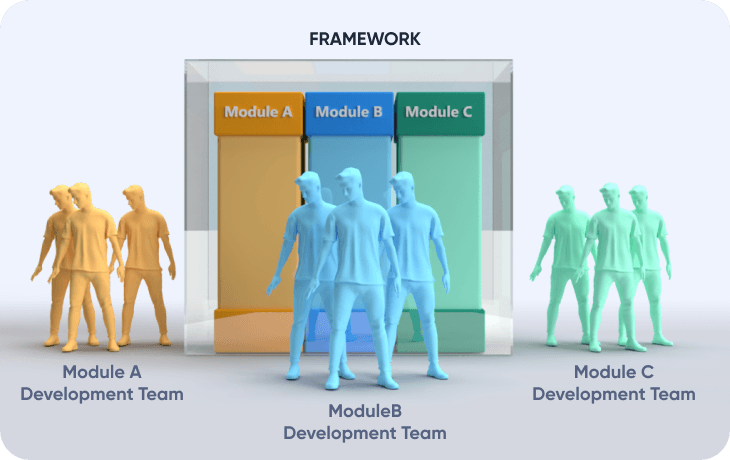Mary Burko
Content Writer, Researcher
What are the Software Design Principles?
2024-02-28
A deep understanding of software design principles is necessary to navigate the intricate maze of code and algorithms. These principles serve as the cornerstone of software engineering, guiding developers in crafting solutions that are not only functional but also maintainable, scalable, and efficient. This comprehensive guide will unravel the essence of software design principles, shedding light on their importance and practical applications in real-world software development projects.
What Are Software Design Principles?
Software design principles encompass fundamental concepts or guidelines that dictate how software systems should be structured, organized, and implemented. These principles are not rigid rules but rather flexible guidelines that inform developers about best practices and strategies for designing robust and resilient software solutions.
Writing code will only consume 20 to 40 percent of the development process. Therefore, a good system design is essential. A good system should have a good code base: easy to read, easy to understand, easy to maintain(add/modify features and fix bugs), and easy to extend the system in the future. That will reduce development time and resources and make us happier.
Basically, software design is only a part of the development process in the design step. Before doing Software Design, we must complete Software Architecture. When choosing an architecture, you will decide how to handle performance, fault tolerance, scalability, and reliability. It is responsible for defining what each module does, class scope, methods, etc. It's similar to building a house or a building.

Why Are Software Design Principles Important?
Understanding and applying software design principles are crucial for several reasons. Firstly, they promote code maintainability by advocating for clean, modular, and well-organized codebases. This makes it easier for developers to comprehend, debug, and extend existing code without introducing unintended side effects or breaking functionality.
Secondly, software design principles facilitate scalability by fostering architectures that can adapt and evolve gracefully as requirements change and user demands grow. By adhering to these principles, developers can design systems that are flexible, extensible, and capable of accommodating future enhancements and optimizations.
Software design principles contribute to the efficiency of software systems by promoting performance optimization, resource management, and code reuse. By following these principles, developers can minimize redundancy, improve code readability, and enhance overall system performance.
The Core Software Design Principles
1. SOLID Principles
SOLID principles were formulated by Robert C. Martin (also known as Uncle Bob) to guide software developers in creating more maintainable, scalable, and robust object-oriented software systems. Let's delve into each principle!

Single Responsibility Principle (SRP)
According to the SRP, a class should only change for one reason. Every class should encapsulate a single function or responsibility. By adhering to this principle, developers can ensure that classes are focused, cohesive, and easier to understand. For example, separate classes may handle employee information, salary calculations, and tax deductions in a payroll system. Each class encapsulates a single responsibility, making it easier to maintain and modify.
Open/Closed Principle (OCP)
The OCP advocates for software entities to be available for extension but closed for modification. This means that classes should be designed to allow new functionality to be added through inheritance or composition without altering existing code. For example, instead of modifying an existing class to accommodate new types of shapes, you can create a new class that inherits from a common Shape base class or implements a Shape interface, thus extending functionality without modifying existing code.
Liskov Substitution Principle (LSP)
It is defined in the LSP that objects of superclasses' subclasses can replace objects of superclasses without affecting their correctness. In other words, derived classes should be substitutable for their base classes without changing the program's behavior. For example, if Square is a subclass of Rectangle, code that works with Rectangle objects should also work with Square objects without any unexpected side effects or behavior changes.
Interface Segregation Principle (ISP)
Using interfaces that clients do not use should not be required, suggests the ISP. Developers should design smaller, more specialized interfaces to meet specific clients' needs instead of large, monolithic interfaces. For example, separate interfaces for Printable, Editable, and Savable can be created in a document editing application instead of a single interface that encompasses all functionalities. As a result, clients can only rely on the interfaces that are relevant to them.
Dependency Inversion Principle (DIP)
The DIP encourages high-level modules to depend on abstractions rather than concrete implementations. By relying on interfaces or abstract classes rather than concrete classes, developers can achieve loose coupling between modules, making the system more flexible and easier to maintain. For example, instead of directly instantiating a database connection object within a service class, the service class relies on an abstraction (e.g., a Database interface) that can be implemented by different database connection classes (e.g., MySQL database, PostgreSQL database).
A SOLID approach allows developers to design modular, flexible, and maintenance-friendly software systems. These principles provide a solid foundation for object-oriented design, enabling developers to create more adaptable software that is resistant to the complexities of evolving requirements.
2. DRY Principle

The DRY (Don't Repeat Yourself) principle is a fundamental tenet in software development that emphasizes avoiding code duplication. At its core, DRY advocates for the abstraction of repeated code into reusable components or functions, ensuring that every piece of knowledge or logic in a system has a single, unambiguous representation.
By adhering to the DRY principle, developers can unlock many benefits that significantly enhance the quality and maintainability of their codebase:
Easier Maintenance
When code is duplicated across multiple places within a system, any updates or modifications must be applied consistently across all instances. This can lead to errors or inconsistencies if changes are missed in some places. By abstracting common functionality into reusable components, developers can centralize maintenance efforts, making it easier to update and refactor code without the risk of overlooking any instances.
Reduced Bugs
Code duplication increases the likelihood of introducing bugs or errors into a system. When the same logic is repeated in multiple places, any bugs or issues in that logic must be fixed in each instance separately. This increases the chances of overlooking a bug and makes debugging and troubleshooting more challenging. By consolidating duplicated code into reusable components, developers can minimize the surface area for bugs and ensure that fixes are applied uniformly across the codebase.
Improved Readability
Duplicated code can clutter the codebase and obscure the underlying logic or intent, making it harder for developers to understand and maintain. By abstracting common functionality into reusable components or functions, developers can eliminate redundancy and promote a more concise and readable codebase. This improves code comprehension and facilitates collaboration among team members, as developers can more easily grasp the purpose and behavior of the code they are working with.
The DRY principle is a guiding principle for software developers, encouraging them to strive for elegance, efficiency, and maintainability in their code. By avoiding code duplication and embracing abstraction and reuse, developers can streamline development efforts, reduce the risk of errors, and create easier codebases to maintain, extend, and understand. Ultimately, adherence to the DRY principle fosters code quality and enhances software systems' overall effectiveness and longevity.
3. KISS Principle

The KISS (Keep It Simple, Stupid) is a foundational concept in software design that champions simplicity over complexity. It advocates for favoring straightforward solutions over convoluted ones to minimize cognitive overhead, reduce development time, and create systems that are easier to understand and maintain.
At its core, the KISS principle emphasizes several critical aspects of software design:
Simplicity
The KISS principle promotes simplicity in design by encouraging developers to choose the most straightforward solution that adequately solves the problem. This involves avoiding unnecessary features, abstractions, or optimizations that may introduce complexity without providing significant benefits.
Clarity
By favoring straightforward solutions, developers can enhance the clarity and transparency of their codebase. Simple designs are easier to understand and reason about, making it easier for developers to grasp the purpose and behavior of the software they are working with.
Maintainability
Complex solutions are more challenging to maintain and modify over time. The KISS principle helps mitigate this by promoting easier to maintain and extended designs. By keeping designs simple and straightforward, developers can reduce the likelihood of introducing unintended side effects or breaking existing functionality when making changes.
Development Efficiency
Simplifying the design of a system can lead to increased development efficiency. By avoiding unnecessary complexity, developers can focus on implementing core functionality and delivering value to end-users. This can result in faster development cycles, shorter time-to-market, and reduced development costs.
In essence, the KISS principle encourages developers to resist the temptation to over-engineer solutions and opt for simplicity wherever possible. By keeping designs simple, developers can improve code quality, enhance maintainability, and create software systems that are more resilient to change and easier to manage in the long run.
4. YAGNI Principle

The YAGNI (You Aren't Gonna Need It) principle is a guiding philosophy in software development that encourages developers to refrain from adding functionality to software until it is deemed necessary. This principle serves as a reminder to avoid speculative or premature optimizations and features that may never be used in practice.
At its core, the YAGNI principle emphasizes several key concepts:
Minimalism
YAGNI advocates for a minimalist approach to software development, where developers prioritize the minimum viable product functionality aspect of immediate needs. This involves focusing on essential features and functionalities while deferring non-essential or speculative features until they are truly needed.
Avoiding Over-Engineering
Premature optimization and over-engineering can lead to unnecessarily complex, bloated, and difficult-to-maintain software. By adhering to the YAGNI principle, developers can avoid the temptation to over-optimize or over-engineer solutions before the requirements are fully understood. Instead, they can focus on delivering simple, straightforward solutions that address users' current needs.
Agile Development
YAGNI aligns well with the principles of agile development, which emphasize iterative development, flexibility, and responsiveness to changing requirements. By deferring non-essential features until they are needed, developers can adopt a Forile mindset and adapt their software to evolving user needs and market conditions more effectively.
Efficiency
By avoiding unnecessary features and optimizations, developers can improve development efficiency and reduce time-to-market. Instead of investing time and resources in implementing speculative features that may never be used, developers focus on delivering essential functionality that provides tangible value to users.
In practice, the YAGNI principle helps developers avoid the potential pitfalls of premature optimization or over-engineering, such as wasted time and resources, increased complexity, and reduced flexibility. By embracing YAGNI, developers can adopt a pragmatic approach to software development, prioritizing simplicity, flexibility, and responsiveness to user needs, ultimately leading to more efficient and successful software projects.
5. SoC Principle

The Separation of Concerns (SoC) principle is another fundamental concept in software engineering that cannot be overlooked. It emphasizes the importance of dividing a software system into distinct modules or layers, each responsible for a specific functionality aspect.
SoC advocates for dividing a software system into modular components or layers, isolating different elements of functionality within separate modules. This helps reduce the complexity of individual components and improves overall system design.
Benefits of SoC:
- Improved Code Readability: SoC improves code readability by isolating and organizing related functionality so developers can better understand individual component purposes.
- Enhanced Maintainability: SoC promotes modularity, making it easier to update, modify, or extend individual parts of the system without affecting others, thus reducing the risk of unintended side effects.
- Increased Testability: Separating concerns simplifies testing by isolating individual components, allowing developers to write focused unit tests for each module and ensuring the overall reliability of the software.
As an example, consider a web application handling user authentication and data storage. By applying the SoC principle, developers can separate concerns into layers like UI, authentication logic, and database access. This organization streamlines understanding of software development journey applications.
In summary, the Separation of Concerns principle plays a crucial role in software design, promoting modularity, flexibility, and maintainability. By dividing software systems into distinct modules or layers, developers can enhance code readability, maintainability, and testability, resulting in more robust and reliable software solutions.
Final Thoughts
In the intricate landscape of software development, understanding and applying software design principles is akin to wielding a compass in a dense forest. These principles serve as guiding stars, illuminating the path toward crafting functional, maintainable, scalable, and efficient software solutions.
At the heart of software design principles lies the essence of structuring, organizing, and implementing software systems. They're not rigid rules but rather flexible guidelines that empower developers with best practices and strategies for creating robust and resilient software.
When embarking on the software development journey, it's crucial to recognize the value of software design principles. They pave the way for code maintainability, scalability, and efficiency by advocating for clean, modular, and well-organized codebases.
Object-oriented design is founded on SOLID principles, which include Single Responsibility, Open/Closed, Liskov Substitution, Interface Segregation, and Dependency Inversion. These principles can help developers create modular, flexible, easy-to-maintain, and extend software systems.
Additionally, fundamental principles like DRY (Don't Repeat Yourself), KISS (Keep It Simple, Stupid), YAGNI (You Aren't Gonna Need It), and SoC (Separation of Concerns) further enrich our understanding of software design. These principles advocate for simplicity, minimalism, and modularity, fostering code quality, maintainability, and testability.
In essence, embracing software design principles isn't just about writing code—it's about sculpting elegant solutions that stand the test of time. Through these principles, we are able to navigate the complex landscape of software engineering with confidence and clarity, ultimately leading to software systems that not only meet but exceed expectations.
